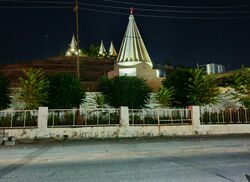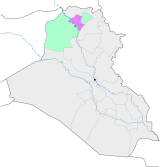بعشيقة
بعشيقة
Bashiqa | |
|---|---|
بلدة | |
 احدى مزارات الديانة الايزيدية في ناحية بعشيقة | |
| الإحداثيات: 36°26′48″N 43°20′50″E / 36.4466°N 43.3471°E | |
| البلد | Iraq |
| المحافظة | نينوى |
| القضاء | الحمدانية |
بعشيقة (كردي: بەعشیقە, romanized: Başîqa,[1][2] العربية: بعشيقة سريانية: ܒܥܫܝܩܐ[3]) هي بلدة تقع في قلب سهل نينوى، بين الموصل وشيخان، على أطراف جبل مقلوب. ناحية بعشيقة التابعة لقضاء الموصل والواقعة شمال شرقه يبلغ تعداد سكانها اكثر من (70000) الف نسمة وهي منطقة غنية بالثقافات اذ تحتوي على ست ثقافات وكما هو واضح على الخارطة وهذا يجعلها اكثر المناطق احتواءاً للثقافات الفرعية، داخل قصبة بعشيقة وبحزاني يوجد اليزيدية بنسبة (70%) والمسيحيون (25%) (سريان كاثوليك وسريان ارثودكس) ويوجد المسلمون بنسبة (5%) وعشرة بيوت من الأكراد البهدينان اما بالنسبة للقرى التابعة للناحية فهناك (47) قرية تحتوي على خمس ثقافات فرعية فالعرب في ست قرى بنسبة (20%) والشبك بنسبة (70%) في عشرين قرية والتركمان بنسبة (5%) في قريتين والعرب المسيحيون بنسبة (5%) ويوجدون في قرية ميركي.
The urban area of Bashiqa and Bahzani had the third largest Yazidi population in Iraq prior to the Sinjar massacre. Whilst Bahzani contains older buildings with numerous ancient sites, Bashiqa is more modern and consists mainly of newer infrastructure and architecture. Between 2014 and 2016, ISIS destroyed 22 Yazidi mausoleums that were located in Bashiqa and Bahzani, the Yazidi libraries were demolished and the famous sacred olive grove in Bahzani was burnt.[4]
Around 85% of the population is Yazidi in 2021. The remaining 15% include around 300 Syriac Orthodox families and 90 Syriac Catholic families.[5]
التاريخ
Although Bashiqa and Bahzani are considered to have already been known to Yezidis as early as 12th century, it seems that it only became part of the Yezidi territory in the 13th century. This is strengthened by the fact that the majority of the mausoleums present here are dedicated to the second generation members of the Shamsani family, whom lived in the second half of the 12th century.[6]
In the mid-1800s, Dr. Asahel Grant visited Bashiqa, which was largely inhabited by Yezidis or "Desani". He took notes on their spiritual practices and beliefs.[7]
Bashiqa is controlled by the Iraqi federal government but claimed by the Kurdistan Region since the fall of Saddam Hussein in 2003. According to Article 140 of the Iraqi constitution, a referendum should decide whether it should continue to be managed by the central government or the KRG. The status of the city is still not fully understood. According to reports by Human Rights Watch (2011), UNHCR (2007) and other human rights organizations the townspeople are forced and threatened with violence if they should not vote for inclusion of the city in the Kurdistan Region.[8][9][10]
In the 13th century, historian, Yaqut al-Hamawi described Bashiqa as a village on the outskirts of Nineveh to the east of the river Tigris which is well known for its olive trees and having a majority Christian population.[11]
Bashiqa is the birthplace of the famed Ezidi Mirza, a 17th century Yezidi leader who became the governor of Mosul and is mentioned in Yezidi sagas and stories until today for his heroic military achievements against the hostile neighbouring Muslim tribes.[12]
قال ياقوت الحموي:
التعداد

Before ISIS invaded the Nineveh plain, there were 35,000 Yezidis living in the Bashiqa and Bahzani twin-villages. They made up approximately 85% of the total population. The remainder was composed of around 12% Christians and 3% Muslims. The lightning progression of ISIS in 2014 forced the inhabitants to flee the area on the night of the 6th and 7th August. The area was liberated on 7th November 2016 and the inhabitants began to return, in 2018 around 27,000 Yezidis had returned, approximately 77% of the pre-ISIS Yazidi population. A further 735 Yezidis displaced who were displaced from Sinjar and were studying in Mosul are presently living here in IDP camps. 525 of the houses suffered damages by ISIS and 200 of them were totally destroyed.[13]
Bashiqa is surrounded by farms of olives all around the town and there is a small mountain to the north. Bashiqa is famous for its olive trees, Rakı (arak), olive oil, and soap. It is also famous for its onion, pickles. It used to be a tourist destination for the locals in Mosul and Iraqis in general. The Yazidis in Bashiqa and its twin village Bahzani speak Arabic as their mother language.[14]
الاقتصاد
تشتهر بعشيقة ب صناعه العرق البعشيقي وفي إنتاج الراشي حيث يوجد أكثر من 10 معامل للراشي داخل بعشيقة وايضا المخلل أو كما يسميه أهل الناحية (الطرشي).
المواقع اليزيدية المقدسة
Bashiqa has numerous Yazidi shrines, including:[15]
- Shrine of Sitt Nefîse ("Lady Precious"; patron of fever and insomnia). Sitt Nefîse is the personification of a sacred fig or olive tree near Bashiqa.
- Shrine of Shehîd ibn Jerr (Seth), the son of Adam and the progenitor of the Yazidis. His tomb and qubbe (conical spire) are at Bashiqa.
- Shrine of Weys el-Qeneyrî (Owais al-Qarani)
- Shrine of Sitt Khadîje el-Kubra (Khadija, the first wife of Muhammad)
- Shrine of Sitt Hebîbe, Marta Hebîbta ("the Beloved Lady"), the wife of Sheikh Muhemmed. She also has a shrine near Bahzani.
- Shrines of Mes‘ûd and Musey‘id
- Malak Miran Temple
أعلام
انظر أيضًا
- ^ "Pêşmerge li Başîqa bi tundî bersiva Daîş dide û şer li Xazir berdewame". Tigris Haber (in التركية). 17 December 2015. Archived from the original on 19 December 2019. Retrieved 19 December 2019.
- ^ "لێدوانی چاوشئۆغڵو لەبارەی عێراق و بەعشیقە". Anadolu Agency (in الكردية). Retrieved 19 December 2019.
- ^ Thomas A. Carlson et al., “Baʿshīqa — ܒܥܫܝܩܐ ” in The Syriac Gazetteer last modified December 9, 2016, http://syriaca.org/place/303.
- ^ "The Yazidi mausoleum of Melek Miran in Bashiqa". Mesopotamia. Retrieved 2021-05-25.
- ^ "Shlama Population Project - Nineveh". Retrieved 20 April 2022.
- ^ "The Yazidi mausoleum of Melek Miran in Bashiqa". Mesopotamia. Retrieved 2021-05-25.
- ^ Grant, A. (1841). The Nestorians. United Kingdom: J. Murray. 31-34.
- ^ "Iraq's Disputed Territories" (PDF). United States Institute of Peace.
- ^ "On Vulnerable Ground" (PDF). Human Rights Watch.
- ^ "UNHCR's Eligibility Guidelines for Assessing the International Protection Needs of Iraqi Asylum-Seekers" (PDF). United Nations High Commissioner for Refugees (UNHCR).
- ^ George, Nashwan (2014). The Villages and Towns Presently Inhabited by the Chaldean Syriac Assyrian (Soraya) People in Iraq. Ishtar TV. p. 102.
- ^ admin (2016-10-01). "Die Geschichte des Ezidi Mirza: Vom Waisenkind zum Helden". ÊzîdîPress (in الألمانية). Retrieved 2021-06-14.
- ^ "The Yazidi mausoleum of Melek Miran in Bashiqa". Mesopotamia. Retrieved 2021-05-25.
- ^ electricpulp.com. "Yazidis i. General – Encyclopaedia Iranica". www.iranicaonline.org. Retrieved 2016-09-25.
- ^ Kreyenbroek, Philip (1995). Yezidism: its background, observances, and textual tradition. Lewiston NY: E. Mellen Press. ISBN 0-7734-9004-3. OCLC 31377794.
- Pages using gadget WikiMiniAtlas
- Short description is different from Wikidata
- Coordinates on Wikidata
- Articles containing كردي-language text
- Pages using Lang-xx templates
- Articles containing explicitly cited عربية-language text
- Articles containing سريانية-language text
- Articles with hatnote templates targeting a nonexistent page
- أماكن مأهولة في محافظة نينوى
- تجمعات آشورية في العراق
- سهل نينوى
- قرى يزيدية في العراق
- مدن العراق
- مناطق آشورية/سريانية/كلدانية
- يزيديون في العراق
- Populated places in Nineveh Governorate
- Assyrian communities in Iraq
- Yazidi populated places in Iraq
- مستوطنات كردية في العراق
- Shabak communities
- CS1 التركية-language sources (tr)
- CS1 الكردية-language sources (ku)
- CS1 الألمانية-language sources (de)



